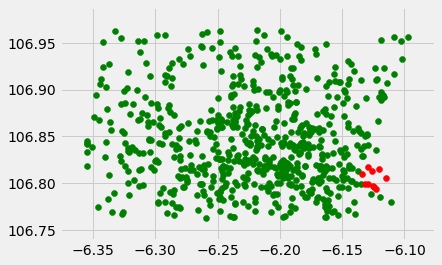Numpy中的mask的使用
2018-07-21 09:52
597 查看
numpy中矩阵选取子集或者以条件选取子集,用mask是一种很好的方法
简单来说就是用bool类型的indice矩阵去选择,
mask = np.ones(X.shape[0], dtype=bool) X[mask].shape mask.shape mask[indices[0]] = False mask.shape X[mask].shape X[~mask].shape (678, 2) (678,) (678,) (675, 2) (3, 2)
例如我们这里用来选取全部点中KNN选取的点以及所有剩余的点
from sklearn.neighbors import NearestNeighbors nbrs = NearestNeighbors(10).fit(X) _,indices = nbrs.kneighbors(X) mask = np.ones(X.shape[0], dtype=bool) mask[indices[0]] = False plt.scatter(X[mask][:,0],X[mask][:,1],c='g') plt.scatter(X[~mask][:,0],X[~mask][:,1],c='r')

带条件选择替换,比如我们需要将a矩阵内某条件的行置换为888剩余置换为999,可以直接用mask或者再用where一步搞定:
mask = np.ones(a.shape,dtype=bool) #np.ones_like(a,dtype=bool) mask[indices] = False a[~mask] = 999 a[mask] = 888 ############# np.where(mask, 888, 999)
以上就是本文的全部内容,希望对大家的学习有所帮助,也希望大家多多支持脚本之家。
您可能感兴趣的文章:
相关文章推荐
- numpy使用
- Python中Numpy包的安装与使用方法简明教程
- numpy简介与使用keras的KNN分类算法
- goodFeaturesToTrack函数中mask的使用
- J2EE 使用maskbarcode.jar实现一维条形码
- 使用easy_install安装numpy、pandas、matplotlib及各种第三方模块
- numpy使用
- opencv中感兴趣区域以及mask的使用
- Numpy 使用教程 5
- 机器学习(三) Jupyter Notebook, numpy和matplotlib的详细使用 (下)
- Python中NumPy简介及使用举例
- setTranslatesAutoresizingMaskIntoConstraints和setFrame组合使用导致的异常
- android多点触控统一的原理(使用 event.getAction()&MotionEvent.ACTION_MASK的原因)
- (原+译)使用numpy.savez保存字典后读取的问题
- 射线碰撞检测+LayerMask的使用
- 使用Numpy和Scipy处理图像
- 使用CALayer的Mask实现注水动画效果
- 使用Python的pip命令安装numpy
- Windows 下,使用 Pycharm + Anaconda(NumPy,SciPy 等集成包)的环境配置
- python中Numpy包的安装及使用
